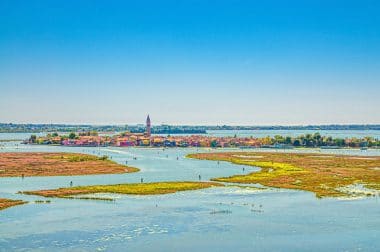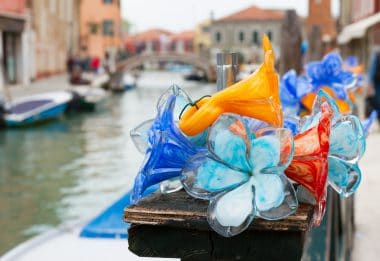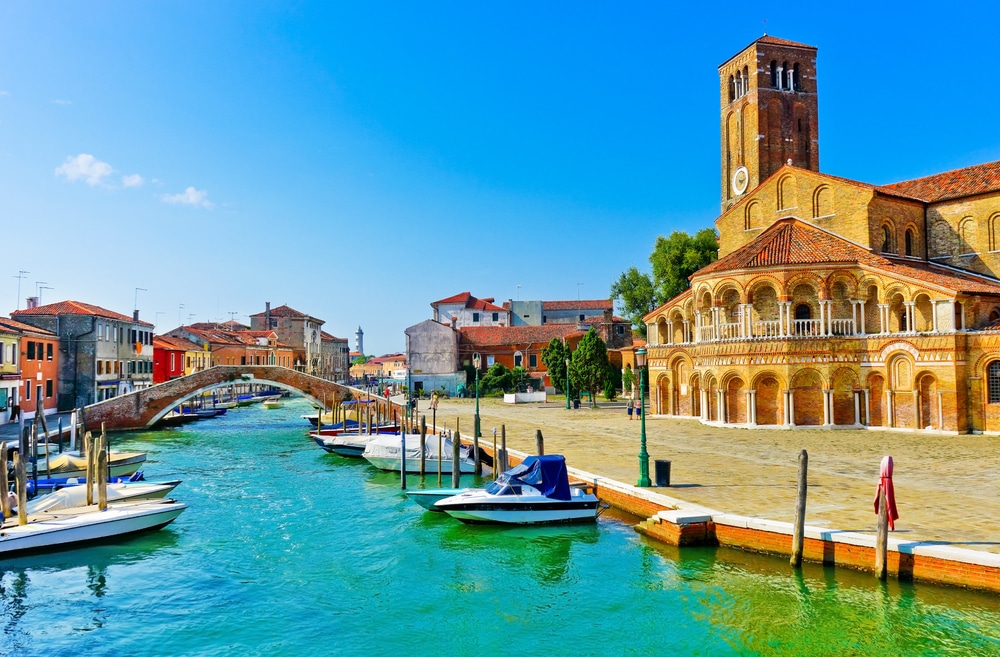If you visit Venice during your holidays, you should not limit yourself to the old town. After an idyllic boat trip, which lasts only three quarters of an hour, you can reach the island of Burano from Venice, densely lined with colourfully painted houses. A walk through the narrow streets of the island makes your eyes glaze over with flashing colors. Halfway between Venice and Burano lies the glassblowing island of Murano, which is best visited at the same time if you are already on the road. In their structure, both islands resemble the Venetian main island. Burano and Murano are each car-free and densely built up with narrowly towering houses. Instead of roads, there are canals here and there, through which the water bus called vaporetto runs. As a pedestrian, the best way to admire the canals and lagoons is from one of the many bridges that span the water arms and lead to the many sights of the two islands.
On the colourful island of Burano

Burano is now one of the most densely populated islands in the Venetian Lagoon. The island is made up of four individual islands, which are connected by bridges. Walking through Burano’s alleys, you will quickly be enchanted by the charm of the brightly painted houses. Burano has been a fishing island since time immemorial. Since it was often difficult for the fishermen to find the right mooring in front of their own fisherman’s cottage through the thick wafts of fog in the foggy lagoon after fishing, they painted their houses in screaming bright colours in different ways. In the past, this served exclusively for better orientation. Today, this preserved peculiarity attracts numerous tourists. Burano’s colorful houses are a popular photo motif for all visitors. The wives of the fishermen, by the way, contributed something to the meagre fishermen’s wages of their husbands by making lace. In the Museo del Merletto, the lace museum, works of art made of high-quality lace are exhibited. The building that houses the museum, the Palazzo del Podestá, dates back to the 13th century and is a work of art in itself. Scarves, tablecloths or garments made of Burano lace can be purchased in many small shops around the museum.
Between the baroque church and the leaning tower of Burano
The Chiesa di San Martino Burano church is definitely worth seeing. Its bell tower catches the eye when you approach Burano by vaporetto. Like its big brother in Pisa , this tower remains in a clear tilt. The church also contains an impressive crucifixion scene by Giovanni Battista Tiepolo. He was one of the most important Venetian Baroque painters. After the sightseeing program, the restaurants and bars on Piazza Galuppi beckon. Connoisseurs say that nowhere else in Italy can you get such excellent risotto as here. Burano is even internationally known for its Fritto Misto, fried seafood that comes straight from the fishing boat to the plate.
Part of Venice since 1924: the glassblowing island of Murano

The island of Murano, which is about one square kilometre in size, was independent for a long time, which is why Murano was able to develop its very own tradition and culture. It was not until 1924 that the island was added to the Venetian city area. Glass has been produced on Murano since the tenth century. Even today, one glassblowing workshop follows the next here. The 5,000 inhabitants of Murano still master this difficult craft. Hand-blown glass from Murano has a more than respectable reputation worldwide, and is now exported in all directions. Visitors to the island can look over the shoulders of the craftsmen as they practice their profession in many workshops. In addition to small craft businesses, there are also some glass factories that can be visited. In the Museo del Vetro, the history of glassblowing is told. The most valuable exhibit is the Coppa Barovier, a blue glass chalice from the 15th century. In the local glassblowing workshops you can buy pretty souvenirs. From glass beads to jewellery and decorative objects such as vases, everything is here.
Churches and sculptures
With the church Chiesa dei Santi Maria e Donato, Murano is one of the oldest churches in the entire region. Its original church was built as early as the seventh century. In the following centuries, the church building was destroyed and rebuilt several times. The church has a free-standing bell tower and a rumored dragon skeleton. The floor of the church consists of colorful mosaic stones. Other churches on the island that are well worth seeing are the churches of San Pietro Martire and Santa Maria degli Angeli. With the Cometa di Vetro, a modern glass sculpture was erected in front of the church of San Pietro Martire. Only ruins can be seen of one of the most beautiful churches on the island, the Santa Chiara Murano, but they are more than worth a look. The Palazzo da Mula from the 15th century inspires especially those interested in architecture. The building is made of red bricks and has late Gothic features. Rich noblemen from Venice used to reside here, who used the palazzo as a summer residence. If you stroll through the alleys of Murano on a city walk, you will also be able to soak up a lot of the Mediterranean flair and the slightly morbid atmosphere of the island.




